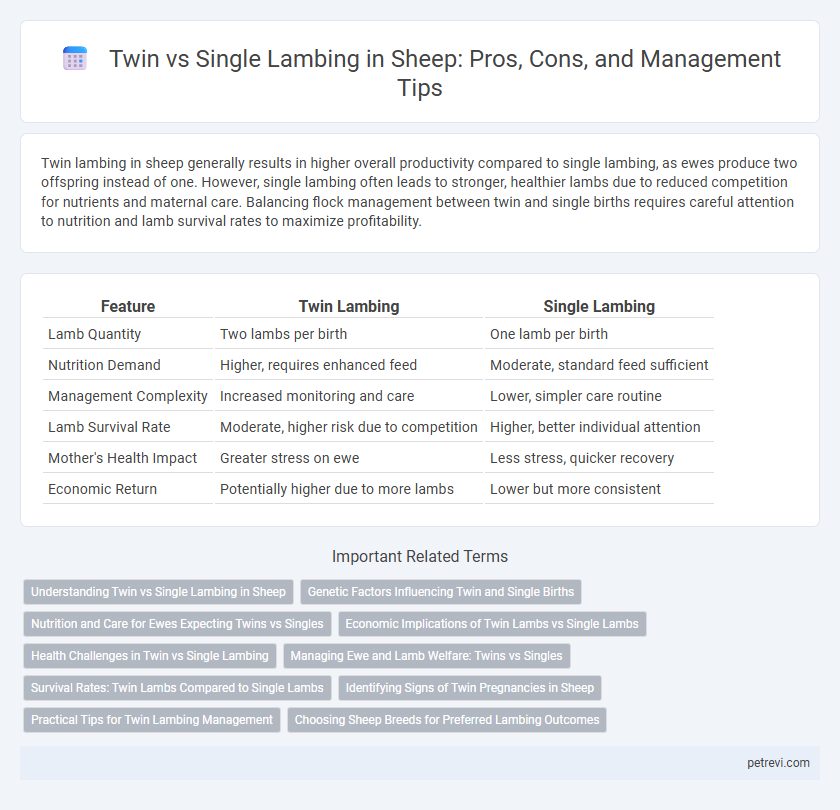Twin lambing in sheep generally results in higher overall productivity compared to single lambing, as ewes produce two offspring instead of one. However, single lambing often leads to stronger, healthier lambs due to reduced competition for nutrients and maternal care. Balancing flock management between twin and single births requires careful attention to nutrition and lamb survival rates to maximize profitability.
Table of Comparison
| Feature | Twin Lambing | Single Lambing |
|---|---|---|
| Lamb Quantity | Two lambs per birth | One lamb per birth |
| Nutrition Demand | Higher, requires enhanced feed | Moderate, standard feed sufficient |
| Management Complexity | Increased monitoring and care | Lower, simpler care routine |
| Lamb Survival Rate | Moderate, higher risk due to competition | Higher, better individual attention |
| Mother's Health Impact | Greater stress on ewe | Less stress, quicker recovery |
| Economic Return | Potentially higher due to more lambs | Lower but more consistent |
Understanding Twin vs Single Lambing in Sheep
Twin lambing in sheep typically results in higher overall flock productivity by doubling the offspring per ewe compared to single lambing, which produces one lamb per birthing event. However, single lambing often leads to stronger individual lambs with higher birth weights and lower mortality rates, benefiting lamb survival and growth. Evaluating factors such as ewe nutrition, genetics, and management practices helps optimize outcomes for either twin or single lambing strategies.
Genetic Factors Influencing Twin and Single Births
Genetic factors play a crucial role in determining the likelihood of twin versus single births in sheep, with certain breeds like the Finnsheep and Booroola Merino genetically predisposed to multiple lambing due to identified genes such as the FecB gene. Ewes carrying the FecB mutation often exhibit increased ovulation rates, leading to a higher chance of twin lambs, while breeds without such genetic markers tend to have predominantly single births. Understanding these hereditary influences allows selective breeding programs to enhance lambing outcomes, optimizing flock productivity and management strategies.
Nutrition and Care for Ewes Expecting Twins vs Singles
Ewes expecting twins require higher energy and protein intake compared to those carrying singles to support fetal development and maintain their body condition. Nutritional adjustments include increasing concentrate feed and providing quality forage to meet the elevated demands, reducing risks of pregnancy toxemia and low birth weights. Enhanced monitoring and targeted supplementation during the last trimester improve lamb survival rates and ewe health in twin pregnancies.
Economic Implications of Twin Lambs vs Single Lambs
Twin lambs significantly enhance lambing productivity by increasing total offspring without requiring additional ewes, often improving farm profitability through higher meat and wool yields per ewe. However, the economic gains from twins can be offset by increased management costs, including higher feed requirements, greater risk of lamb mortality, and more intensive care needs to ensure both lambs thrive. Single lambs generally require less resource input and present lower health risks, resulting in reduced labor and veterinary expenses, but produce lower overall output per ewe compared to twins.
Health Challenges in Twin vs Single Lambing
Twin lambing in sheep often presents heightened health challenges compared to single lambs, including increased risks of low birth weight and hypothermia due to competition for limited uterine resources. Nutritional demands on the ewe are significantly higher in twin pregnancies, which can lead to compromised colostrum quality and quantity, impacting lamb immunity and survival rates. Monitoring and providing targeted supplementation during gestation are critical to mitigating these health risks and improving outcomes in twin lamb lambing scenarios.
Managing Ewe and Lamb Welfare: Twins vs Singles
Managing ewe and lamb welfare during lambing requires different strategies for twins versus singles, as twin lambs demand more maternal resources and increased monitoring to ensure equal access to colostrum and warmth. Ewes carrying twins often experience greater nutritional needs and stress, necessitating enhanced feeding programs and regular health checks to prevent complications like pregnancy toxemia. Ensuring proper bonding, adequate shelter, and timely intervention for both singles and twins is crucial to reduce lamb mortality and improve overall flock productivity.
Survival Rates: Twin Lambs Compared to Single Lambs
Survival rates for twin lambs are generally lower than those for single lambs due to increased competition for nutrients and maternal care during gestation and after birth. Single lambs receive more focused attention and nutrition from the ewe, resulting in higher birth weights and stronger immune responses. Twin lamb survival can be improved with proper management practices such as supplementary feeding and close monitoring during lambing.
Identifying Signs of Twin Pregnancies in Sheep
Twin pregnancies in sheep often present with larger abdominal size and increased udder development compared to single pregnancies. Palpation and ultrasound scanning between 60-90 days of gestation provide accurate identification of twin fetuses. Recognizing these signs early enables tailored nutrition and management to support optimal lambing outcomes.
Practical Tips for Twin Lambing Management
Managing twin lambing requires ensuring adequate nutrition and monitoring ewe body condition to support the higher energy demands of twins compared to singles. Provide separate feeding areas and increased space for ewes with twins to reduce stress and promote healthy lamb growth. Close observation during lambing and prompt assistance can reduce mortality rates, as twin births carry a higher risk of complications than single lambs.
Choosing Sheep Breeds for Preferred Lambing Outcomes
Selecting sheep breeds like Dorset or Finnsheep increases the likelihood of twin lambing due to their high fecundity rates, while breeds such as Suffolk typically produce single lambs, favoring ease of management. Twin lambing offers greater flock growth potential but requires enhanced nutritional support and monitoring to reduce lamb mortality. Understanding breed-specific reproductive traits helps farmers align lambing outcomes with their production goals, optimizing both flock size and animal welfare.
Twin vs Single for Sheep Lambing Infographic

 petrevi.com
petrevi.com